"Silent" deployment to Prince Hassan Air Base (H5), Jordan
Latest update: November 28, 2009
By Joachim Jacob (all author rights reserved)
Please also note the copyrights of posted photos taken by Warthog News contributors.

Royal Jordanian Air Force (RJAF) Air Bases (Map by Scramble)
Originally, all Operation Iraqi Freedom (OIF) deployment locations in the Kingdom of Jordan were officially "classified" or at least "undisclosed" by the U.S. military, mainly related to diplomatical demands by Jordan as the host nation. But in fact, the U.S. military itself disclosed all of these locations. At first by some "leaks" (personal e-mails), and later also by semi-official or official reports, including some official USAF news photos.
In an article "Joint Fires Support, the Joint Fires Element and the CGRS: Keys to Success for CJSOTF-West", published in Special Warfare, April 2005, Col. Robert B. Green (director of the joint-fires element for CJSOTF-W during initial combat operations in OIF) explained:
During the early, pre-deployment planning phase of Operation Iraqi Freedom, the combined-force commander gave Combined Joint Special Operations Task Force-West, or CJSOTF-W, the mission of interdicting ground-based time-sensitive targets, or TSTs, in the western desert of Iraq in support of the combined force air-component commander, or CFACC, and the CFACC's counter-SCUD mission.
The mission marked two firsts: (1) For the first time, the CFACC had operational control of an extensive piece of ground — the entire western desert of Iraq, which was his assigned area of operations, or AO; (2) CJSOTF-W, a subcomponent of the Combined Force Special Operations Component commander, or CFSOCC, was designated as the supporting commander for the mission — the first instance of a SOF task-force commander serving as a supporting commander to the CFACC.
CJSOTF-W comprised units from the U.S. 5th Special Forces Group and the British and Australian Special Air Service regiments. Its C-SCUD mission would become the largest coalition SOF operation in history.
To plan the mission, CJSOTF-W established a coalition working group consisting of planners from the U.S. Air Force Air Combat Command, or ACC; the U.S. Central Command Air Force, or CENTAF; other government agencies and coalition special-operations planners from CJSOTF-W's U.S., British and Australian contingents. [...]
The CFACC established a dedicated air wing, the 410th Air Expeditionary Wing, or AEW, which consisted of strike assets from the Air National Guard, the Air Force Reserve and the British Royal Air Force, to support the C-SCUD mission.
The operation became the first instance in which a SOF task force received all of its apportioned close air support, or CAS, as well as much of its support for air-interdiction, or AI, from a single, dedicated air wing.
Dedicated joint-fires support available to CJSOTF-W included CAS from the 410th AEW, AI support from both the 410th AEW and other CENTAF assets, and AC-130 gunship support from JSOAD-W. [...]
Source
Another related source:
HOW THE WEST WAS WON: THE ESSENCE OF NETWORK-CENTRIC OPERATIONS (NCO) BY MAJOR BROOK J. LEONARD, THESIS PRESENTED TO THE FACULTY OF THE SCHOOL OF ADVANCED AIR AND SPACE STUDIES FOR COMPLETION OF GRADUATION REQUIREMENTS SCHOOL OF ADVANCED AIR AND SPACE STUDIES AIR UNIVERSITY MAXWELL AIR FORCE BASE, ALABAMA, JUNE 2006
Please note: At least from my viewpoint, the quoted assignment of 24 A-10s is incorrect! I got confirmed info for only 18 A-10s.
Related books
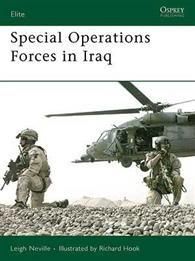
Cover of "Special Operations Forces in Iraq", published as Elite 170 in November 2008 by Osprey Publishing; Author: Leigh Neville, Illustrator: Richard Hook; Paperback; 64 pages; ISBN: 9781846033575
Intelligence specialist Leigh Neville identifies, describes and illustrates the Special Operations Forces (SOF) of the US and other Allied (Coalition) forces committed to war in Iraq since 2003, providing a fascinating insight into specific operations, detailing weapons, equipment and experiences in combat. With a surprising amount of recently declassified material from government departments that are yet to be published in the mass media, this is a ground-breaking analysis of the largest mobilization of Special Forces in recent history.
With extensive first-hand accounts providing an eyewitness perspective of the fighting on the ground and including information on the US Delta Force, the British SAS, Australian and Canadian special forces as well as CIA and MI6 operational units this book provides a crucial study of their skills and success in Iraq from the Battle of Debecka to storming the safe house of Uday Hussein. In a controversial war that has been plagued by high fatalities and military blunders, this book highlights the successes enjoyed by Special Forces operatives. This book serves as a companion volume to Elite 163: Special Forces Operations: Afghanistan. Extensive preview

Cover of "ALL ROADS LEAD TO BAGHDAD - Army Special Operations Forces in Iraq", by Charles H. Briscoe, et al
"All Roads Lead to Baghdad" was written in a clear and concise style, free of military jargon, by U.S. Army Special Operations Command (USASOC) historians to document the exploits and achievements of individual Army special operations soldiers and units in their traditional role of supporting the conventional force during Operation Iraqi Freedom in 2003. It is the second in this USASOC series; the first (Weapon of Choice: ARSOF in Afghanistan) chronicled the invasion of Afghanistan shortly after September 11, 2001, and is also reprinted by Paladin Press under the title U.S. Army Special Operations in Afghanistan. This historic book details the planning and direction provided by Gen. Tommy Franks to U.S. Special Operations Command Central and on down the line to the two Combined Joint Special Operations Task Forces (North and West), and a Naval task force - and then, as in all campaigns, how the units and individual soldiers executed their specific missions with courage and skill. To ensure accuracy in their reporting, the authors received unparalleled access to classified documents and personal accounts from soldiers on the battlefield. ISBN: 978-1-58160-600-3; softcover; 552 pages;6" x 9"; maps, color photos, illust. Source
Note: I will order this book to get some more first-hand info about CJSOTF-West. I already buyed "U.S. Army Special Operations in Afghanistan" (also by Paladin Press) for better understanding combat of Operation Enduring Freedom in Afghanistan.
The 410th Air Expeditionary Wing
Especially for the Scud-hunting mission and to support other special operations forces tasks in western Iraq, in Jordan, Air Combat Command (ACC) activated the 410th Air Expeditionary Wing at Muwaffaq Salti Air Base – Azraq (also known as Shahid Muafaq Al-Salti Air Base), dubbed Azraq Air Base by the U.S. military. During their shorttime OIF deployment the 410th AEW's nonsecured public e-mail adress was …@azab.aorcentaf.af.mil (azab = Azraq Air Base, aorcentaf = Area of Responsibility, Central Command Air Forces, af = Air Force, mil = Military).
Fighting alongside their fully integrated special operations ground task forces, the 410 AEW's pilots, flying F-16C and A-10 aircraft, pursued enemy equipment, personnel, and high-value targets, including regime leadership. In total, the wing flew 9,651 fighter and attack hours in twenty-six days flying counter-tactical ballistic-missile missions and never left the special operations forces in western Iraq without air cover. Often flying in extremely hazardous conditions in and around Iraq, the wing's crews generated 2,547 sorties, providing around-the-clock, time-sensitive targeting, interdiction, OCA (offensive counterair), CAS (close air support), ISR (intelligence, surveillance, and reconnaissance), and CSAR (combat search and rescue) missions deep within enemy territory. These missions were flown from bare bases with little supporting infrastructure and necessary logistics. The wing accurately employed more than 600 precision-guided munitions and expended a total of 800,000 pounds of weapons. In addition to eliminating TBM support equipment, the wing is credited with destroying aircraft, armored vehicles, artillery pieces, surface-to-air missile systems, ammunition supply dumps, radars, and enemy troops. The wing is also credited with the destruction of two Baath Party headquarters buildings in western and central Iraq. Although the wing was engaged in more than 200 troops-in-contact scenarios, there were no fratricide events. During OIF, 410th personnel supplied thirty F-16s, four HH-60s, four HC-130s, eight RAF GR.7 Harriers, and two PR.9 Canberras with 130,000 gallons of fuel per day for twenty-three days.

The 410th Expeditionary Operations Group patch. Their motto was "Seek & Destroy". Visible in a clockwise direction are pictograms of RAF GR.7 Harrier, F-16, A-10, HC-130 and HH-60. Also pictured are the flags of United States, Australia, and United Kingdom.

During OIF's main combat phase, the 410th AEW was commanded by Col. Stanley E. "Sid" Clarke III, at that time 187th Fighter Wing commander, Dannelly Field, Montgomery, Alabama, photographed here as Brigadier General. Now a Major General, he's a command pilot with more than 4,000 hours in the A-10, C-26 and the F-16, including more than 100 combat hours. (U.S. Air Force photo) Source His current official USAF online biography

Most popular USAF picture. Original photo caption: US Air Force (USAF) Air National Guard (ANG), F-16C Fighting Falcon aircraft arrive at an undisclosed location in support of Exercise Rugged Arch. Camera Operator: SSGT Bennie J. Davis III, USAF (Date Shot: 15 Feb 2003) Hi-res
Note: At USAF's website this photo was first released in a "WEEK IN PHOTOS" section (Week of February 28, 2003). The original photo caption was: "OPERATION ENDURING FREEDOM – F-16 Fighting Falcons from Colorado, Alabama and Illinois Air National Guard units arrive at an undisclosed location supporting Operation Enduring Freedom." As I remember, sometime later the caption was modified and more related to Rugged Arch, but I have no print-out. And after searching USAF's online photo archive again in January 2006, I'm sure this pic is not more online. The Illinois ANG must be an USAF editor's error.
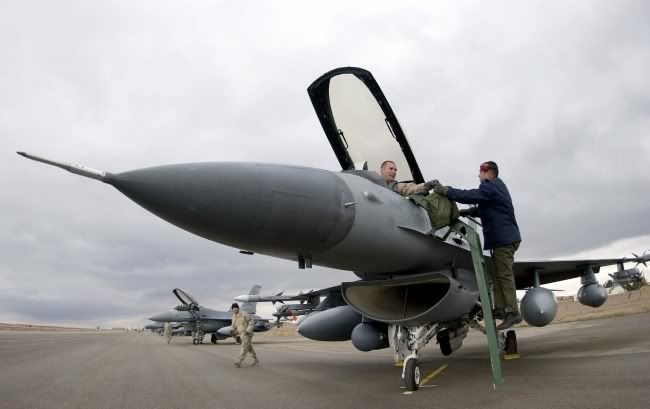
Most important USAF picture. Original photo caption: A US Air Force (USAF) Air National Guard (ANG), F-16C Fighting Falcon Pilot is greeted by a Crew Chief, from the Jordanian Royal Air Force and USAF 410th Air Expeditionary Wing (AEW) Crew Chiefs, after arriving at an undisclosed location in support of Exercise Rugged Arch. Camera operator: SSGT Bennie J. Davis III, USAF (Date Shot: 15 Feb 2003). Note: This photo was never published at USAF's public main website, and also never at DoD's public main website. The aircraft in the background is F-16C 86-0346 from the 160th Fighter Squadron. Hi-res
Both photos are still online on servers of dodmedia.osd.mil. That's the website of the Defense Visual Information Center (DVIC) at March Air Reserve Base, Moreno Valley, California. DVIC is a division of the American Forces Information Service (AFIS), which is a field activity of the Secretary of Defense.
The 410th AEW's deployed location is up today officially still "classified" but already known both by deployed personnel (logically) as well as by well-informed non-military circles.
But if DVIC official states for public that the F-16C pilot was "greeted by a Crew Chief, from the Jordanian Royal Air Force and USAF 410th Air Expeditionary Wing (AEW) Crew Chiefs", then it's absolutely clear that the 410th AEW was activated somewhere in Jordan. And if USAF stated that the F-16s on the first photo were from Colorado and Alabama Air National Guard units, then it's also clear that the 120th EFS, the 160th EFS, and all of the related support personnel were deployed to a Jordanian air base. In this case, the U.S. military themselves has disclosed at least the host nation.

OIF, February 16, 2003: This wide-angle view shows only a very small part of the 410th AEW's tent city. Visible in the background is a MIM-104 Patriot Missile Battery. The building complex on the horizon at right must be the desert castle Qasr Uwaynid. (USAF photo) Hi-res

First known official 410th AEW OIF F-16C combat picture. Original photo caption: US Air Force (USAF) munitions personnel assigned to the 410th Air Expeditionary Wing (AEW) at a forward deployed location work on guided munitions on the pylon of an USAF F-16 Fighting Falcon. The Falcon has an AIM-120A Advanced Medium Air-to-Air Missile (AMRAAM) a fixed to the wing tip. The 410th AEW prepare the aircraft for take off for sorties on A-Day, the commencement of the air war for Operation IRAQI FREEDOM, at a forward location. Camera Operator: SSGT Bennie J. Davis III (Date Shot: 21 Mar 2003). Note: The aircraft is 87-0282 from the 160th FS. Hi-res
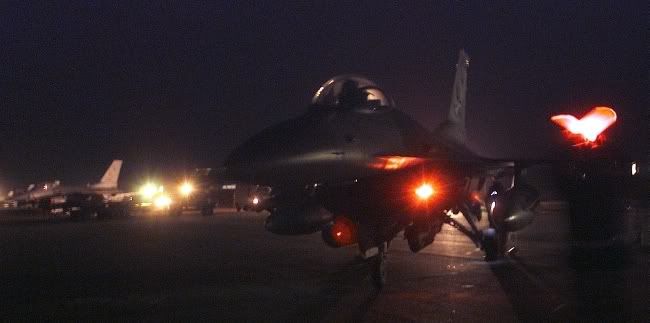
Second known official 410th AEW OIF F-16C combat picture. F-16 Fighting Falcons from the 410th Air Expeditionary Wing taxi in after a long reconnaissance mission at a forward-deployed location supporting Operation Iraqi Freedom. (U.S. Air Force photo)

Cover of the book F-16 FIGHTING FALCON UNITS OF OPERATION IRAQI FREEDOM, written by Steve Davies and Doug Dildy, and published 2006 by Osprey Publishing as Osprey Combat Aircraft 61.
As a freelance aviation journalist and photographer, in this book Steve Davies undisclosed some more 410th AEW info. For first time ever in a print media, he also undisclosed Azraq Air Base as deployed location (just after my posts on F-16.net).
Shahid Muafaq Al-Salti Air Base (Azraq Air Base)
Situated in the midst of the desert, the oasis town of Azraq (also known as Al Azraq) lies 45-50 miles or 103 kilometres east of Amman. Once an important meeting of trade routes, it performs a similar function today although the camels have been replaced by trucks. It forms a junction of roads heading northeast to As Safawi and further to Iraq, and southeast to Saudi Arabia. As such, the roads are dominated by large transport and diesel fumes. Azraq is divided in Azraq South and Azraq North. Azraq al-Janubi (South Azraq) stretches about 1 km south of the conjunction, while Azraq ash-Shomali (North Azraq), where the famous Qasr al-Azraq fortress (see T.E. Lawrence – Lawrence of Arabia) is located, starts about 5 km to the north. Azraq al-Janubi is basically a truckstop and it's also known as Azraq ash-Shishan after one of the springs there.
According to "Scramble", the base with their runway (Rwy 13/31) is geographically located at: Position 31° 49' 59.8N Longitude: 36° 47' 1.8E, Elev: 1706 ft.

An older satellite picture of Shahid Muafaq Al-Salti Air Base (Azraq Air Base), Jordan, located opposite west from South Azraq (Satellite photo via Google Earth)
For more 410th AEW F-16 info (including some more pictures and serial numbers of all deployed Vipers, verified by involved crew chiefs, please check my research topic Operation Iraqi Freedom (F-16 Combat History)
The 387th Air Expeditionary Group
As a large and widely independently subordinated unit, the 387th Air Expeditionary Group (387th AEG) was activated at Prince Hassan Air Base Prince Hassan Air Base (also known as H5) near As Safawi. Originally, H5 was a British designation for one of the formerly oil pump stations on an old oil pipeline across Iraq and Jordan (since years not in use, but most with at least one associated airfield). The related non-secured public e-mail adress for Prince Hassan Air Base (or H5) was …@phab.aorcentaf.af.mil.
The 387th AEG was a blend of attack and reconnaissance forces, consisting of close to 500 104th FW personnel and totaling around 1,300. The group was commanded by Col. Michael R. Boulanger, 104th FW commander. Vice commander was Lt. Col. L. Scott Rice, 104th OG commander. The deployments started in mid-January 2003 when Col. Boulanger and a group of about 30 left for the Middle East to prepare for the arrival of others. Six of the unit's A-10 left in mid-February, followed by five more. They were joined by seven A-10s from the 103rd FW. During the force build-up for OIF, elements from both squadrons teamed up to form the 131st Expeditionary Fighter Squadron.
The 131st FS and the 118th FS were selected in fall 2002 to be the first ever to modify A-10s for employing the Litening AT targeting pod. This advanced pod allowed the drop of 500-pound GBU-12 Paveway II laser guided bombs without external guidance.

Prince Hassan Air Base (Satellite photo via Google Earth)
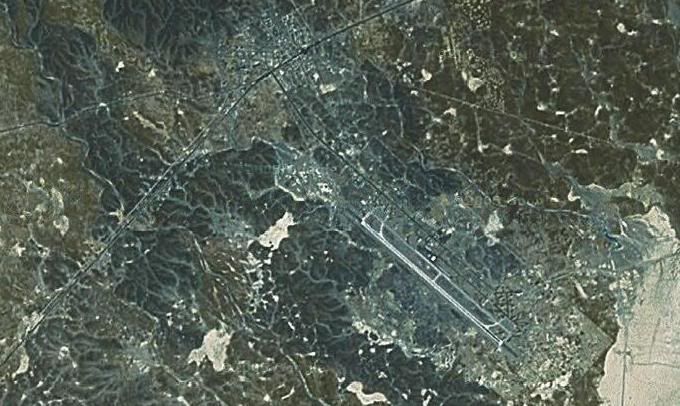
An older satellite picture of Prince Hassan Air Base, located near As Safawi, Jordan. Full size (Satellite photo via Google Earth)
Deployed A-10s
131st FS, 104th FW (Massachusetts ANG), Barnes MAP (MA)
11 A-10s:
78-0583
78-0612 (Mission markings: 14 bombs, 7 stars)
78-0614 "Town of Russel"
78-0616 "Town of South Hadley"
78-0624
78-0626 "Town of Southwick"
78-0642 "City of Springfield" (Mission markings: 8 bombs, 8 stars)
78-0644 "City of Boston"
78-0647
78-0649 "Town of Southampton"
78-0659
118th FS, 103rd FW (Connecticut ANG), Bradley ANGB (CT)
7 A-10s:
78-0613
78-0615 ??? (according to mission markings)
78-0633
78-0707
81-0960
82-0646 ??? (according to mission markings)
Together, the deployed A-10 pilots logged 1,119 sorties and 3,821 flying hours (3,100 combat hours during 900 sorties) with no combat losses or battle damage. The missions included 35 CSAR sorties, with the rescue of an aircraft crew and numerous medical evacuations to the unit's credit.
All 18 aircraft arrived as formation over Bradley IAP on April 29, 2003. Diverting to the west of the air base, the formation split up. The 104th FW aircraft swung north, the 103rd FW aircraft went on to Hartford for a fly-by salute at the state Capitol before touching down one by one.


An older satellite picture of Prince Hassan Air Base, located near As Safawi, Jordan. Full size (Satellite photo via Google Earth)
387th AEG leadership

Retired Col. Michael R. Boulanger, photographed as Mayor of Westfield, Massachusetts About the Mayor (including his military career)
From that file:
Commander, 387th Air Expeditionary Group, Base Y (classified Middle East location) Feb 2003-Jun 2003 Commander of a combined Group (387th AEG) at an austere Middle East location shared with U.S. Army and Allied Special Operations ground and aviation units during Operation Iraqi Freedom (OIF – Jan-May 2003). Responsibilities included acquiring available property from the host nation and building the base operating and living area for conducting 24 hour combat operations. Responsible for: -1,200 people consisting of both active duty and reserve component personnel -18 Aircraft (A-10 Fighter Squadron) and 60 A-10 pilots, -Expeditionary Medical Squadron (EMEDS +25), -UAV (9 UE-Predator) Squadron, -Maintenance and Support Squadrons, -Air Traffic Control Flight, -Combat Communications Squadron, -Special Tactics Squadron, OSI, TALCE, -Expeditionary Mobile Aeromedical Staging Facility (E-MASF) and -Two Critical Care Air Transport Teams (CCATT). Planned and conducted joint combat operations in close coordination with co-located Army Ranger and Allied Special Operations forces. In addition to 78 Predator combat missions, the 387th AEG successfully flew 892 A-10 combat missions (3,147 hours, 98.7% sortie effectiveness, 99.8% mission capable rate) in support of the counter ballistic missile threat mission and close air support, including 35 combat search and rescue sorties with two confirmed saves with no combat damage or losses. Maintained a close cooperative working relationship with host nation military commander(s) and American Embassy representatives. Closely coordinated all U.S. Contractor (Kellogg, Brown & Root) activities and developed host nation base support agreements. Developed bare-base security and Ability to Survive and Operate (ATSO) procedures, conducted frequent exercises to ensure base attack/survival procedures were effective and understood by every member
Vice Commander, 410th Air Expeditionary Wing, Base X (classified Middle East location) Jan 2003 Vice-Commander of a combined Wing at an austere Middle East location shared with U.S. Air Force and British Air Forces aviation units during Operation Iraqi Freedom (OIF). Responsible for acquiring available property from host nation and building the base operating and living area for conducting 24 hour combat operations. Assisted in directing over 2,500 people consisting of both active duty and reserve component personnel comprising an three F-16 Fighter Squadrons, an A-10 Fighter Squadron, a Rescue Squadron (EC-130 & HH-60), a Canberra Squadron and a Harrier Squadron, associated Maintenance and Support Groups, an Expeditionary Medical Squadron (EMEDS +25), Air Traffic Control Flight, Combat Communications Squadron, and TALCE. Maintained close, cooperative working relationship with host nation military commanders, coordinating activities and support agreements as well base security and ATSO procedures.
Note: An official military biography of retired Col. Michael R. Boulanger is not more online today.

L. Scott Rice, photographed as Brigadier General and the Assistant Adjutant General-Air, Joint Force Headquarters, Massachusetts National Guard, Milford, Massachusetts Official biography (As of current)
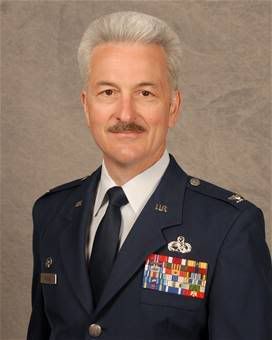
Colonel Frederick R. Miclon Jr., photographed as vice commander of the 103rd Airlift Wing, Connecticut Air National Guard. From May 2000 to August 2004, he commanded the 103rd Maintenance Group of the 103rd Fighter Wing. In February 2003, Lieutenant Colonel Miclon, along with 300 members of the 103rd Fighter Wing of the Connecticut Air National Guard, was mobilized by presidential order for deployment to Southwest Asia for what became Operation IRAQI FREEDOM. He was subsequently awarded the Bronze Star for meritorious achievement as commander of the 387th Air Expeditionary Group Maintenance Squadron during his three-month deployment, marking the start of the on-going war in Iraq. Official biography (As of current)
First-hand combat reports, including A-10 pilot's views
Shortly after OIF's main combat phase, aviation author John "Spoons" Sponauer from United States did a great job to collect very first-hand info of related A-10 involvements.
He had a chance to talk to one of the 103rd Fighter Wing pilots who deployed for OIF to ask his opinions about the LITENING targeting pod, how A-10s were used in Operation Iraqi Freedom, and his experiences in combat over the western desert. His interview DESERT LITENING - THE 103rd FW IN IRAQI FREEDOM was originally published May 10, 2004, on SimHQ.com. It's the only related A-10 pilot interview known to me. Just an excerpt:
The majority of what the public knows about the war in Iraq comes from the eastern part of the country….the drive up through the river valleys into Baghdad. Much of what happened in the western desert seems more 'black.' Even the location of your forward base seems to be classified to this day. Please tell us a little about the type of missions you typically flew out in the Wild West.
I'm not sure the location of our base will ever be declassified.
We initially planned for TST (time sensitive targeting) missions. Using JSTARS and other aircraft for targeting, our primary responsibility was the identified 'SCUD zones' that Hussein had used during the first Gulf War to launch SCUD missiles at Israel. Our basic mission was to prevent launches from those zones this time around. In this war, however, all of the ballistic missiles went south instead. So that's the mission we stepped out the door with. As the war progressed, our mission rolled into traditional A-10 missions like CAS (close air support) and CSAR (combat search and rescue) more often. The other type of mission was on-call attack, road reconnaissance, and that type of sortie, especially along the Syrian border helping to prevent Iraqi leadership from leaving the country. We were involved in operations that helped catch at least one of the 'deck of cards,' for instance. The western war was unique. It was more focused on special operations, including working with foreign special operations.
Describe a typical mission for us. Duration? Size of packages? Loadout? Other aircraft?
We broke our squadron down into 'day guys' and 'night guys.' You didn't want to move people around between the two because it would play havoc with sleep cycles. A typical night mission would start at around 3 to 6 PM in the afternoon, when the crew would go into the briefing and check the weather, which was often bad. Crews would learn the target set for the mission, but mostly it was based around 30-40 points in the region that we knew were sources of past activity. We'd take off, hit the tanker, and begin our TST tasking. We often found and killed stuff at those points, mostly related support equipment. So that's at least how it started in the beginning of the war. As the war went on, during some battles like Hadithah Dam, for instance, we saw more CAS tasking. In that case, ground forces were preventing the dam from being blown up by the Iraqis, and our missions in support of that operation were more traditional close air support.
Flights were almost always a two-ship; occasionally four-ships. We didn't have much SEAD (suppression of enemy air defenses) support out in the west. As for other aircraft in the area, there was everything…..B-52s, F-16s, F-14s, and F-15Es…you name it. [...]
In the November 2004 issue of Atlantic Flyer John Sponauer published his interesting article: East Coast "Hog Drivers" Are Here For The Long Haul, again with details about the 387th AEG.
Only an excerpt:
The latest chapter in the A-10's history was Operation Iraqi Freedom. East coast "Hog drivers" provided close air support (CAS) for the march to Baghdad and participated in secret operations over western Iraq. The success of the former reinforced it as the world's premier CAS aircraft; the latter served as testament to its flexibility.
In early 2002, rumors circulated among A-10 units that they were destined for Afghanistan; three prepared for deployment. In July, however, members of the 103rd and 104th FW were summoned to Langley AFB for a surprise; they were not going to Afghanistan after all, but instead preparing for a special mission in the looming Iraq conflict. Using a targeting pod called LITENING II, they were to hunt ballistic missile launchers in western Iraq and support special operations there. For an aircraft designed so austerely that it didn't originally have an autopilot or internal navigation system, LITENING was a huge leap forward. It allows pilots to designate targets for laser-guided bombs (LGB), view targets up to 30 miles away through infrared and camera optics, and accurately determine target range and location. The only prior targeting system in the A-10 was the eyeball; its primary weapons, the 30mm. GAU-8 cannon, unguided bombs, rockets, and AGM-65 Maverick missiles.
By fall, two aircraft and key personnel were in Nellis AFB, Nevada. Under cover of night, jets were modified to accept LITENING. There was no manual for doing so, but after a day of running wires and integrating the pod, they were ready to try the new "eyes."
Following successful dry runs at Nellis with special operations, a combined unit of 18 aircraft from Connecticut and Massachusetts deployed in February to a still-undisclosed Middle Eastern base. Col. Fred Miclon, then 103rd Maintenance Group commander and with more than 20 years of experience with A-10's, was one of about 35 advance personnel.
"This was a bare bones, austere location," he said. "Fortunately, the aircraft is pretty rugged, and we worked hard to set everything up. Within about 10 days, we had 800 people supporting us."
When war came, the Hog drivers in the west dropped laser-guided bombs, assisted special operations, and as the situation developed, provided close air support near the dam at Hadithah, Iraq. They flew 3,100 combat hours during 900 sorties, without damage from enemy fire, and became the first A-10 pilots to drop laser-guided bombs in combat.
Lt. Col. John "Guinness" Stout of the 103rd was among them. On the war's first day, he and his wingman, from the 104th, were on a daytime mission to find a threat target when they encountered another.
"I was using my pod to locate our target when [my wingman] looked up and noticed basketball-sized clouds all around. He saw glints on the ground, and quickly realized that he was under fire, probably by 57mm AAA. After offsetting ourselves from the threats, he talked my eyes onto the guns. We used the pod to determine coordinates, received permission to engage, and lased the target."
"I made a pass and 3-4 miles away, pickled an LGB. I immediately did a gut check - 'had I done everything right?' As I rolled away, I could see the bomb in flight, and thought 'Awesome, but there's no way that's going to reach.' But it was a 'shack;' direct hit. Although we had practiced it many times, this was the first actual delivery made by our 'laser/bomber' team."
Other public info archived by me:
104th Fighter Wing recognized with Air Force Outstanding Unit Award with Valor (published by "abc40" on March 17, 2004):
(Westfield-) -- The 104th Fighter Wing (FW), Massachusetts Air National Guard, Barnes Air National Guard Base has been awarded the Air Force Outstanding Unit Award with Valor by the U.S. Air Force for its role in Operation Iraqi Freedom from January 1, 2003 to May 21, 2003.
During that period, the 104th FW deployed about half its personnel, some 500, and 11 of its 17 A-10 Thunderbolt II attack aircraft to a classified location in Southwest Asia. There, under the overall command of the 410th Air Expeditionary Wing, U.S. Central Command Air Forces, the 104th FW was the lead unit of the 387th Air Expeditionary Group, a combined unit consisting of 1300 personnel housed at an austere location near the Iraqi border. The 387th AEG was further comprised of an A-10 squadron, a Predator Unmanned Aerial Vehicle Squadron, an Emergency Field Medical Squadron and Hospital and other Special Operations personnel. The commander of the 387th AEG was Col. Michael R. Boulanger, 104th FW Commander. The Outstanding Unit Award was awarded to all of the ten units that comprised the 410th AEW.
The mission of the 104th FW/387th AEG/410th AEW was to accomplish the President of the United States' goal of preventing the entry of neighboring countries into the conflict by denying battle space necessary to launch Theatre Ballistic Missiles from western Iraq, essentially, an "anti-Scud" effort. Other mission parameters were to operate as the primary Combat Search and Rescue airborne platform for the entire theater and to provide Close Air Support and Air Interdiction in support of ground troops.
Backed by hundreds of support and maintenance personnel, the 104th FW's A-10s and their pilots flew every day of the war, amassing 1119 sorties, 892 during the war, for a total of 3821 hours with no combat losses, battle damage or significant personal injury, compiling a 99 percent Mission Effectiveness Rate. They also flew 35 Combat Search and Rescue (CSAR) missions in support of ground personnel. These flying totals represent the equivalent of 75 percent of the flying done in a "normal" year done in a few weeks.
As part of the war preparations, the 104th FW was selected to be the first A-10 unit to implement the Litening II Targeting Pod Program. The Litening II Pod is a precision targeting pod system that significantly increases the combat effectiveness of the aircraft. The addition of this pod to an A-10 by the 104th was a pioneering effort - no pods had existed on any A-10s, in the Air Force up to this point. In a very short timeframe, beginning in fall of '02, wing personnel installed, trained maintainers and pilots and made adjustments, resulting in 34 modified aircraft, 18 modified pods and 54 qualified pilots in less than three months.
Note: As an exception that's the full article, probably widely based on the award citation. Anyone from involved personnel who can and will me provide a copy of the original citation? I would be very grateful.
General Tommy Franks discusses conductiong the war in Iraq (Edited transcript of an interview by "Knight Ridder Newspapers", published on June 19, 2003):
"The second front: We knew that one of the strategic dislocators, as it had been in 1991, would be an attack on either Jordan or Israel, or perhaps both. So we knew we needed to gain control of the western desert, 25 percent of Iraq, as quickly as possible, and we decided that the best way to do that was with Special Operations forces. We decided that the number of SF operators would need to be rather large, 25 to 50 A Teams, and others from three other nations. So control of western desert was a second front, and we knew we needed to do that very, very early."
"We said one of the first things we better do is get the Special Operators out and in control of the western 25 percent of Iraq, so we better introduce them first. A little known fact is that the introduction of those forces in the west was ahead of the operations that were much reported, air and ground operations, from the south. By the time operations started in the south, we already had between 25 and 40 SF teams operating in the west."
"They were able to do this without being compromised, except that the regime knew they were there. They knew they were there and they didn´t know why. On of the ingredients of that was the taking out of 100 visual observation posts between the border with Jordan and Iraq, and between the border with Saudi Arabia and Kuwait. So we took out half of those one night, introduced SF operators, and took out the other half the next night."
"You may recall the embedding of reporters. Well, we did not embed reporters with special operations forces at this point because we did not want to take any chance of this leaking into the press about operations in the west until we had denied the regime the opportunity to use the SCUD missiles. So SF was first."
Note: At this time General Tommy Franks was the U.S. Central Command commander.
The exactly location of the 387th AEG was mainly disclosed by U.S. news media reports about Charlie Company, 2nd Battalion, 124th Infantry Regiment, Florida National Guard:
"USA Today" (July 16, 2003)
After several weeks of training, his company arrived at Prince Hassan Air Base in Jordan on Feb. 16. Their mission was to provide security and search-and-rescue support to the special operations forces.
Because of diplomatic sensitivities in Jordan, coalition operations launched from there before and during the war were cloaked in secrecy. Much of what went on has still not been fully disclosed. But Wershow´s [Army Spc. Jeffrey Wershow] unit became one of the first to enter Iraq as the war began. Under cover of darkness and using night-vision googles to see, they breached dirt berms on Iraq´s borders with Jordan and Saudi Arabia to allow special operations forces to drive through
"Military Times" (via "Air Force Times", September 10, 2003)
From day one it was intense. The "secret" commando base was set up at a Jordanian airfield, dubbed "H-5", in the rocky eastern desert along the Iraq border. […] At the time, Jordanian officials strenuously denied that any coalition forces based in the country would be used for an assault against Iraq. But tell that to an Orlando guardsman who was inside the mission buildup, and you will get an eye-rolling chuckle in response. […] As the prewar preparations increased, the number of troops at H-5 swelled to nearly 6,000. The base eventually played host to the "Nightstalkers" of the 160th Special Operations Aviation Regiment, operatives from the British and Australian Special Air service, officers from "other government agencies" – the term often used to describe the Central Intelligence Agency, Defense Intelligence Agency and National Security Agency – and even a detachment of Air Force A-10 "Warthog" attack jets.
For more 410h AEW info please check my topic Operation Iraqi Freedom (F-16 Combat History) on F-16.net.
The only known official USAF photos:
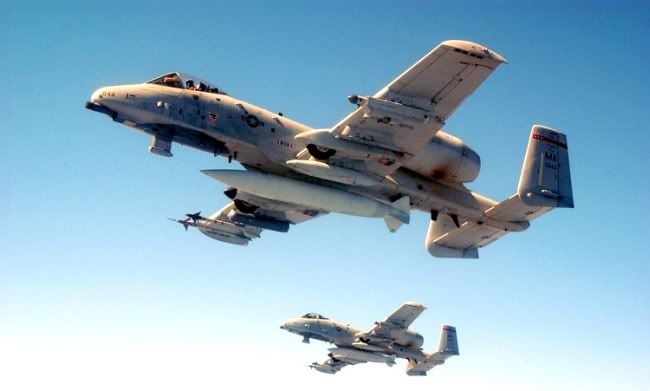
A-10s 78-0644 (foreground) and 78-0614 from the 131st Fighter Squadron fly over the Mediterranean Sea enroute to a forward operating base. (U.S. Air Force photo by Master Sgt. Mark Bucher) Mid-res
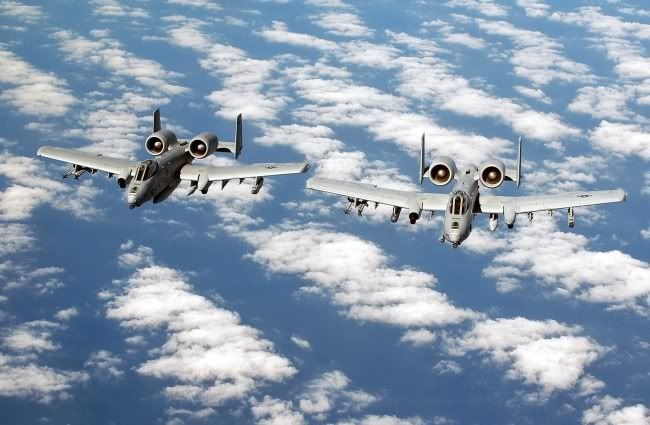
A-10s 78-0614 (left) and 78-0644 from the 131st Fighter Squadron fly over the Mediterranean Sea enroute to a forward operating base. (U.S. Air Force photo by Master Sgt. Mark Bucher) Hi-res
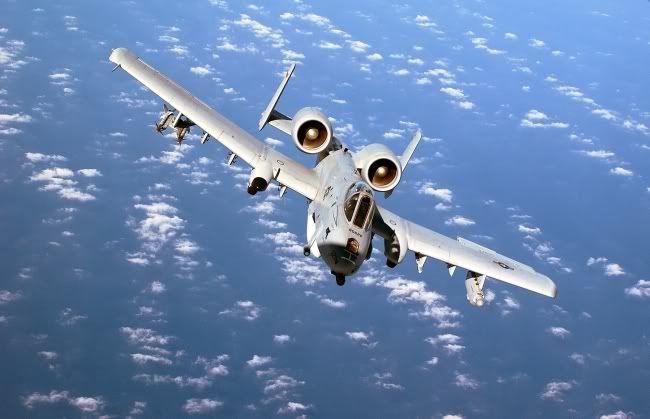
A-10 78-0626 from the 131st Fighter Squadron banks while flying accross the Mediterranean Sea enroute to a forward operating base. (U.S. Air Force photo by Master Sgt. Mark Bucher) Hi-res

An A-10 from the 118th Fighter Squadron over western Iraq during Operation Iraqi Freedom. LITENING II targeting pod on station 9. (Photo by 103rd Fighter Wing Public Affairs) Source
Unfortunately, neither USAF nor DoD released any related OIF A-10 photos taken at Prince Hassan Air Base, and also there were no embedded U.S. news media people in contrast to the 332nd AEW at Ahmed Al Jaber Air Base, Kuwait. I only remember a DoD photo of a Predator UAV together with a Jordan F-104 Starfighter (lost by harddrive crash). I would be very grateful for any private shot taken by people of the Warthog community!
Some private shots, taken during this deployment, were published online:

A-10 78-0642 from the 131st Fighter Squadron. Visible loadout: Dual Rail Adapter (DRA) with two AIM-9M Sidewinder missiles on station 11, AN/AAQ-28 LITENING AT targeting pod on station 9, external fuel tank on centerline station 6. (Photographer unknown)
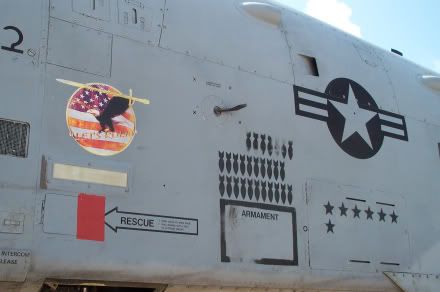
OIF mission markings (28 bombs, seven stars). (Photographer unknown)
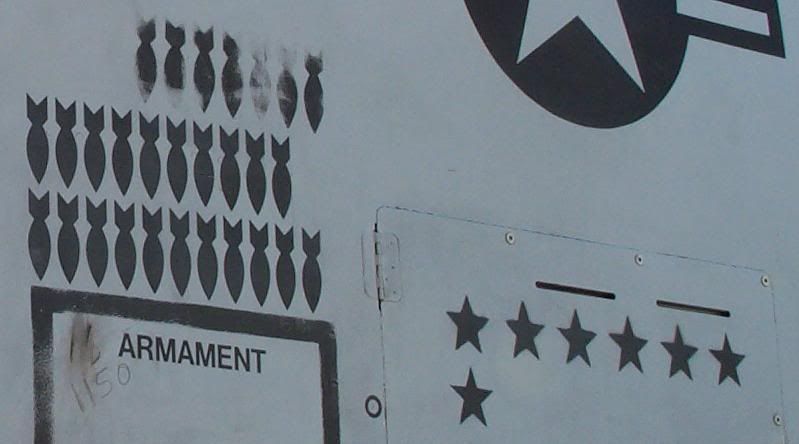
Close-up of the same mission markings. (Photographer unknown)
387th AEG A-10 OIF mission markings
The following pictures were taken by Warthog News contributors Ken Middleton and Dave O'Brian from United States during base visits sometime after the jets returned home:
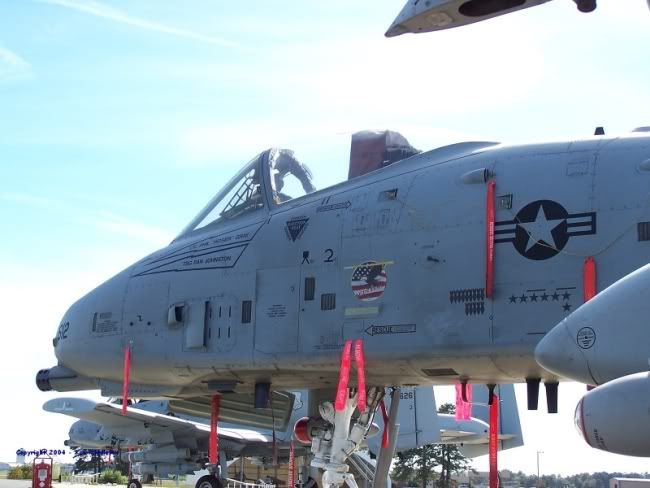
A-10 78-0612 from the 131st Fighter Squadron still with OIF mission markings: 14 bombs, 7 stars. (Photo by Ken Middleton)
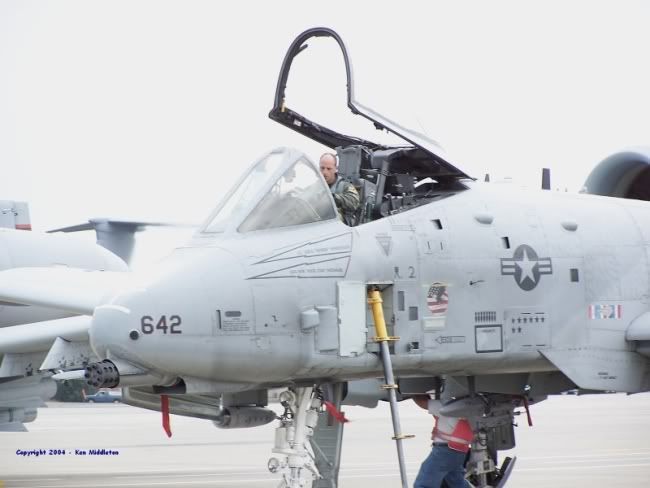
A-10 78-0642 from the 131st Fighter Squadron still with OIF mission markings: 8 bombs, 8 stars. (Photo by Ken Middleton)
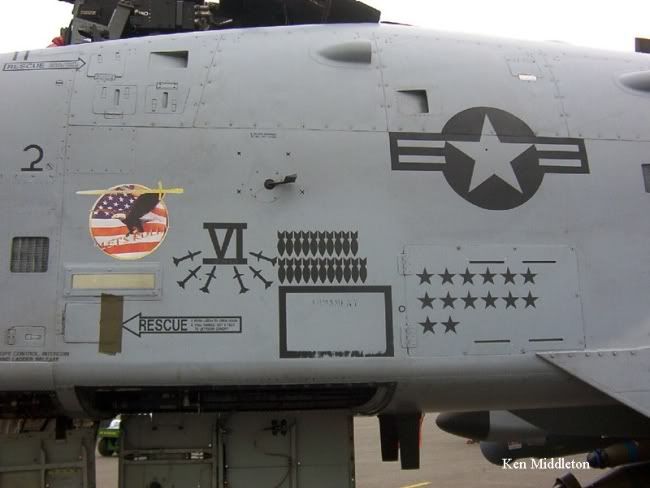
A-10 78-0626 from the 131st Fighter Squadron still with OIF mission markings: 21 bombs, 14 stars, and six missiles with the inscription "VI". (Photo by Ken Middleton)
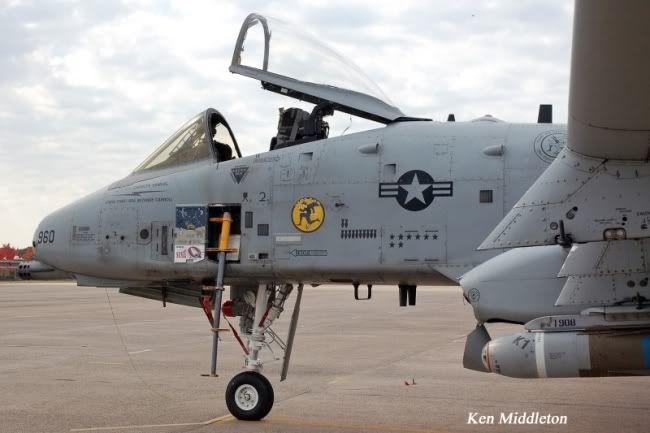
A-10 81-0960 from the 118th Fighter Squadron still with OIF mission markings. (Photo by Ken Middleton)

A-10 82-0646 from the 118th Fighter Squadron still with OIF mission markings. (Photo by Ken Middleton)

A-10 78-0615 from the 118th Fighter Squadron still with OIF mission markings. (Photo by Ken Middleton)
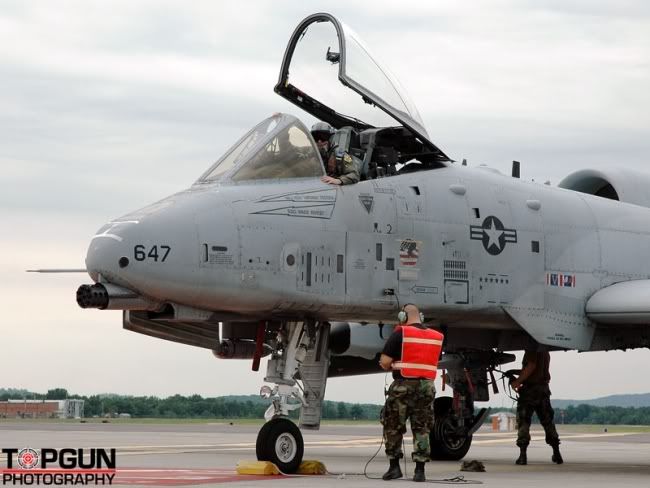
A-10 78-0647 from the 131st Fighter Squadron still with OIF mission markings - a lot of bombs, and seven stars. (Photo by Dave O'Brian)
387th AEG A-10 OIF artwork
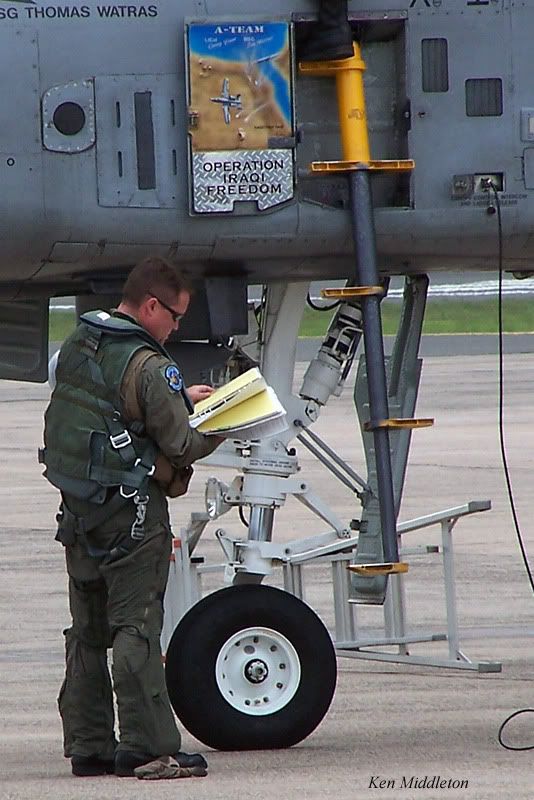
Clear OIF ladder door art on A-10 82-0646 from the 118th Fighter Squadron. (Photo by Ken Middleton)
Deployed with the 387th AEG was artist Roy Walton. Let me post some quotes from a news article published in 2003 by "The Farmington Valley Post":
- Avon resident Roy Walton, 39, is a member of the 103rd unit - the Fighter Wing is an Air National Guard unit in peacetime that became an Air Force unit when it was called to active duty in January - that left Connecticut for a base in southwest Asia March 10.
- As a logistics squadron commander, Walton was in charge of getting the 18 jets, about 700 people and over a million tons of cargo shipped to the base in just a month and a halfe.
(I archived some more related info)
On his website, Roy published the following two very interesting pictures:

Roy's caption: A painting done as a moral booster for the flightline of the 387th Air Expeditionary Group. The best A-10 Wing in the Iraqi conflict operating out of a classified location. Done with acrylic paints on plywood, measures about 4 x 4 feet. Source

Roy's caption: A painting of the Dark Horseman modified to represent the 387th Air Expeditionary Group. The best A-10 Wing in the Iraqi conflict operating out of a classified location. The shield represents the sword of St Michael which the unit used on it's patch. Done with a variety of paints on plywood measuring about 3x4 feet. Source
The following picture is published on Philippe Colin's website:

Original caption: During the 2003's Airshow and Open House, Camp "Kick Ass" was recreated with many items brought back from the Gulf and many displays intended to show the public what the 104th had done during Operation Iraqi Freedom. From February 4 until May 1, 2003 the unit had flown 882 combat sorties and a total of 3146.7 flying hours.
Source
Related patches
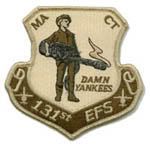 Could be the regular 131st EFS patch of this 387th AEG deployment. Source
Could be the regular 131st EFS patch of this 387th AEG deployment. Source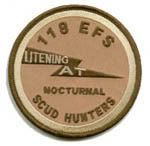 Another patch with the inscription "118 EFS LITENING AT NOCTURNAL SCUD HUNTERS" Source
Another patch with the inscription "118 EFS LITENING AT NOCTURNAL SCUD HUNTERS" Source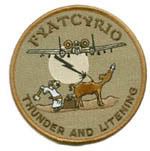 Another patch with the inscription "FYATCYRIO - THUNDER AND LITENING" Source
Another patch with the inscription "FYATCYRIO - THUNDER AND LITENING" SourceBTW: I would be very grateful for any additional first-hand info from U.S. service members who were deployed with the 387th AEG.
















